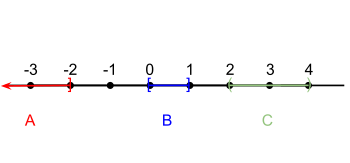Kompaktan prostor — разлика између измена
. |
(нема разлике)
|
Верзија на датум 8. март 2019. у 06:27
U matematici, i specifičnije opštoj topologiji, kompaktnost je svojstvo koje generalizuje pojam podskupa Euklidovog prostora koji je zatvoren (da sadrži sve svoje granične tačke) i ograničen (onaj kod koga sve njegove tačke leže na datom fiksnom rastojanju jedna od druge). Primeri su zatvoreni interval, četvorougao, ili konačni set tačaka. Ovaj je pojam definisan za opštije topološke prostore, nego što je Euklidov prostor na razne načine.[1][2]

Један корисник управо ради на овом чланку. Молимо остале кориснике да му допусте да заврши са радом. Ако имате коментаре и питања у вези са чланком, користите страницу за разговор.
Хвала на стрпљењу. Када радови буду завршени, овај шаблон ће бити уклоњен. Напомене
|
Jedna takva generalizacija je da je topološki prostor sekvencijalno kompaktan ako svaki infinitivni niz tačaka uzet kao uzorak prostora ima beskonačni podniz koji konvergira u istu tačku prostora. The Bolzano–Weierstrass theorem states that a subset of Euclidean space is compact in this sequential sense if and only if it is closed and bounded. Thus, if one chooses an infinite number of points in the closed unit interval [0, 1] some of those points will get arbitrarily close to some real number in that space. For instance, some of the numbers 1/2, 4/5, 1/3, 5/6, 1/4, 6/7, … accumulate to 0 (others accumulate to 1). The same set of points would not accumulate to any point of the open unit interval (0, 1); so the open unit interval is not compact. Euclidean space itself is not compact since it is not bounded. In particular, the sequence of points 0, 1, 2, 3, … has no subsequence that converges to any real number.
Apart from closed and bounded subsets of Euclidean space, typical examples of compact spaces include spaces consisting not of geometrical points but of functions. The term compact was introduced into mathematics by Maurice Fréchet in 1904 as a distillation of this concept. Compactness in this more general situation plays an extremely important role in mathematical analysis, because many classical and important theorems of 19th-century analysis, such as the extreme value theorem, are easily generalized to this situation. A typical application is furnished by the Arzelà–Ascoli theorem or the Peano existence theorem, in which one is able to conclude the existence of a function with some required properties as a limiting case of some more elementary construction.
Reference
- ^ Bartle, Robert G.; Sherbert, Donald R. (2000). Introduction to Real Analysis (3rd изд.). New York: J. Wiley.
- ^ Fitzpatrick, Patrick M. (2006). Advanced Calculus (2nd изд.). Belmont, CA: Thomson Brooks/Cole. ISBN 0-534-37603-7.
Literatura
- Alexandrov, Pavel; Urysohn, Pavel (1929), „Mémoire sur les espaces topologiques compacts”, Koninklijke Nederlandse Akademie van Wetenschappen te Amsterdam, Proceedings of the section of mathematical sciences, 14.
- Arkhangel'skii, A.V.; Fedorchuk, V.V. (1990), „The basic concepts and constructions of general topology”, Ур.: Arkhangel'skii, A.V.; Pontrjagin, L.S., General topology I, Encyclopedia of the Mathematical Sciences, 17, Springer, ISBN 978-0-387-18178-3.
- Arkhangel'skii, A.V. (2001). „Compact space”. Ур.: Hazewinkel Michiel. Encyclopaedia of Mathematics. Springer. ISBN 978-1556080104..
- Bolzano, Bernard (1817), Rein analytischer Beweis des Lehrsatzes, dass zwischen je zwey Werthen, die ein entgegengesetzes Resultat gewähren, wenigstens eine reele Wurzel der Gleichung liege, Wilhelm Engelmann (Purely analytic proof of the theorem that between any two values which give results of opposite sign, there lies at least one real root of the equation).
- Borel, Émile (1895), „Sur quelques points de la théorie des fonctions”, Annales Scientifiques de l'École Normale Supérieure, 3, 12: 9—55, JFM 26.0429.03
- Boyer, Carl B. (1959), The history of the calculus and its conceptual development, New York: Dover Publications, MR 0124178.
- Arzelà, Cesare (1895), „Sulle funzioni di linee”, Mem. Accad. Sci. Ist. Bologna Cl. Sci. Fis. Mat., 5 (5): 55—74.
- Arzelà, Cesare (1882—1883), „Un'osservazione intorno alle serie di funzioni”, Rend. Dell' Accad. R. Delle Sci. Dell'Istituto di Bologna: 142—159.
- Ascoli, G. (1883—1884), „Le curve limiti di una varietà data di curve”, Atti della R. Accad. Dei Lincei Memorie della Cl. Sci. Fis. Mat. Nat., 18 (3): 521—586.
- Fréchet, Maurice (1906), „Sur quelques points du calcul fonctionnel”, Rendiconti del Circolo Matematico di Palermo, 22 (1): 1—72, doi:10.1007/BF03018603.
- Gillman, Leonard; Jerison, Meyer (1976), Rings of continuous functions, Springer-Verlag.
- Kelley, John (1955), General topology, Graduate Texts in Mathematics, 27, Springer-Verlag.
- Kline, Morris (1972), Mathematical thought from ancient to modern times (3rd изд.), Oxford University Press (објављено 1990), ISBN 978-0-19-506136-9.
- Lebesgue, Henri (1904), Leçons sur l'intégration et la recherche des fonctions primitives, Gauthier-Villars.
- Robinson, Abraham (1996), Non-standard analysis, Princeton University Press, ISBN 978-0-691-04490-3, MR 0205854.
- Scarborough, C.T.; Stone, A.H. (1966), „Products of nearly compact spaces” (PDF), Transactions of the American Mathematical Society, Transactions of the American Mathematical Society, Vol. 124, No. 1, 124 (1): 131—147, JSTOR 1994440, doi:10.2307/1994440.
- Steen, Lynn Arthur; Seebach, J. Arthur Jr. (1995) [1978], Counterexamples in Topology (Dover Publications reprint of 1978 изд.), Berlin, New York: Springer-Verlag, ISBN 978-0-486-68735-3, MR 507446
- Willard, Stephen (1970), General Topology, Dover publications, ISBN 0-486-43479-6
Spoljašnje veze
- Countably compact at PlanetMath.org.
- Sundström, Manya Raman (2010). „A pedagogical history of compactness”. arXiv:1006.4131v1 [math.HO].